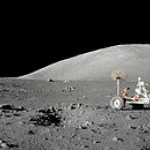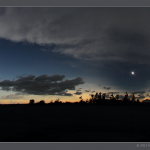Astronomy
“Curiosity is the essence of human existence. ‘Who are we? Where are we? Where do we come from? Where are we going?’… I don’t know. I don’t have any answers to those questions. I don’t know what’s over there around the corner. But I want to find out.” -Eugene Cernan, last human on the Moon
It's been nearly 43 years since humans have set foot on the Moon, and yet we've never forgotten what it looks like.
Image credit: NASA / Apollo 17 / East view of station 1, via http://www.lpi.usra.edu/resources/apollopanoramas/.
Yet nothing that anyone can describe -- either about what it was like or…
“As a boy I believed I could make myself invisible. I’m not sure that I ever could, but I certainly had the ability to pass unnoticed.” -Terence Stamp
When you take a look at the stars visible in the night sky, you're only seeing a tiny fraction of what's actually present in our galaxy. Your intuition would tell you that you're probably seeing the closest stars to Earth, but that's only partially right.
Image credit: Richard Powell of http://www.atlasoftheuniverse.com/.
Of the ten closest star systems in the night sky, only two of them are visible to the naked eye, and if we start to…
Imagine the surface of the Moon, so distant, and an infinitely precise and powerful laser pointer. With a flick of your wrist, you can send the dot that you see flying across the Moon's surface as quickly as you can manage.
Image credit: Sabine Hossenfelder.
Without too much difficulty, in fact, you'll find yourself breaking the speed of light! Not in terms of violating special relativity or anything, but if you follow the motion of the dot, you'll not only find that it appears to move faster than the speed of light in a vacuum, c, but that its behavior is more interesting -- and more…
“Look and think before opening the shutter. The heart and mind are the true lens of the camera.” -Yousuf Karsh
When you find an incredibly huge, dense collection of mass, all together in one place, it generally indicates a galaxy cluster of tremendous size.
Image credit: NASA, ESA, G. Tremblay (ESO), M. Gladders and M. Florian (University of Chicago), S. Baum, C. O’Dea, K. Cooke (RIT), M. Bayliss (Harvard-Smithsonian Center for Astrophysics), H. Dahle (University of Oslo), T. Davis (ESO), J. Rigby (NASA/GSFC), K. Sharon (University of Michigan), E. Soto (Catholic University of America), and…
“Her will tells nearly all. She left an estate worth $314.91, mostly in Liberty Bonds, with a few items such as a desk valued at $5. She never married and had few living relatives. She also left behind a legacy of a great astronomical discovery.” -Jeremy Bernstein, on Henrietta Leavitt
Today is International Women's Day, and to celebrate, I not only have a killer cover by Cat Power that gives an amazing amount of actual emotion to Oasis' bland-pop hit from the 1990s,
Wonderwall,
but a story that left perhaps the greatest legacy in all of astronomy. I can think of no better way to celebrate…
“Surprise is the greatest gift which life can grant us.” -Boris Pasternak
When it comes to theoretical physics, you might realize the entire point is to set up a framework to predict what phenomena are going to occur in the Universe. So if you rewind the clock back to very early times, set up the initial conditions and apply those laws, you would expect to get our Universe out, if we've gotten things correct.
Image credit: Wikimedia Commons user Unmismoobjetivo; of a logarithmic view of the Universe as centered on the Earth.
And if we don't have things figured out properly? We'll…
“Since you cannot do good to all, you are to pay special attention to those who, by the accidents of time, or place, or circumstances, are brought into closer connection with you.” -St. Augustine
When you look up at the sky, all the twinkling lights -- the stars -- appear to be fixed.
Image credit: The Curious Skywatcher, via http://curiousskywatcher.blogspot.com/2012/04/zodiacal-light-your-best-….
But littered among them are the non-twinkling wanderers: the planets. Just 11 days ago, the Mars/Venus conjunction occurred, giving us a spectacular view of two naked-eye planets separated by a…
“Beauty is unbearable, drives us to despair, offering us for a minute the glimpse of an eternity that we should like to stretch out over the whole of time.” -Albert Camus
There's nothing quite like the plane of our Milky Way galaxy. Some 200-400 billion stars are located there, including our own Sun. From our vantage point within it, most of these are obscured by the dust lanes present within.
Image credit: NASA/JPL-Caltech/the GLIMPSE team.
But thanks to its views in infrared light, the Spitzer Space Telescope can glimpse not only all of the stars and the dust simultaneously, it can do it…
“End? No, the journey doesn’t end here. Death is just another path, one that we all must take. The grey rain-curtain of this world rolls back, and all turns to silver glass, and then you see it.” -J.R.R. Tolkien
No matter how well we care for our bodies, they eventually wear down, give out, and we all will someday face death. Yet if there's anything to be learned from looking at the physical Universe, there's no reason to expect that death is truly the end.
Image credit: NASA/ISS Expedition 28.
Every time a star runs out of fuel and dies, no matter what type of star it is or what fate…
No one science can stand wholly on its own. For inquiry about the Universe to give a correct, complete picture, it requires that we bring in a whole slew of evidence, often from tangentially related fields.
Image credit: Professor Kenneth R. Lang, Tufts University.
The interplay between three fields in particular -- astronomy, physics, and math (not a science, but the tool used to help understand the relationships arising in the first two) -- have given rise to the most successful picture of the Universe of all-time.
But how did this come to be?
Image credit: Scott Dodelson.
Brian…
“These spots have never been observed by anyone before me; and from my observations of them, often repeated, I have been led to the opinion which I have expressed, namely, that I feel sure that the surface of the Moon is not perfectly smooth, free from inequalities and exactly spherical… but that, on the contrary, it is full of inequalities, uneven, full of hollows and protuberances, just like the surface of the Earth itself, which is varied everywhere by lofty mountains and deep valleys.” -Galileo Galilei, of his observations of the Moon, 1610
When it comes to the Moon, there are no shortage…
“For my confirmation, I didn’t get a watch and my first pair of long pants, like most Lutheran boys. I got a telescope. My mother thought it would make the best gift.” -Wernher von Braun
A telescope is only as good, mind you, as the amount of time you spend looking through it. And for most people, perhaps unfortunately, that isn't very often.
Image credit: Mike Hankey, via http://www.mikesastrophotos.com/planets/amateur-astronomer-strikes-agai….
Which is why, if we want people to experience the joys of what's actually out there in the night sky -- firsthand -- it's up to us to bring…
“In the year 1456 … a Comet was seen passing Retrograde between the Earth and the sun… Hence I dare venture to foretell, that it will return again in the year 1758.” -Edmond Halley
When ESA's Rosetta mission "caught" its target, Comet 67P/Churyumov-Gerasimenko in August, 2014, one of its main science goals was to watch the comet become active from up close.
Image credit: ESA/Rosetta/NAVCAM — CC BY-SA IGO 3.0, via http://www.esa.int/spaceinimages/Images/2015/02/Comet_on_31_January_201….
Half a year later, the flux of particles being emitted by the comet has intensified tremendously, and so…
“We like to admit to only that which already glows, although it is nobler to support brightness before it glows, not afterwards.” -Dejan Stojanovic
When we look back to greater and greater distances in the Universe, we're looking back to earlier and earlier times as well. At some point, we can see far enough back that we reach the location at which the Universe cooled enough to first form stable, neutral atoms.
Image credit: NASA / CXC / M.Weiss.
But this is no nearby location: it's presently located some 45.3 billion light-years away! All the stars, galaxies, clusters and gas clouds that…
“Girls blush, sometimes, because they are alive, half wishing they were dead to save the shame. The sudden blush devours them, neck and brow; They have drawn too near the fire of life, like gnats, and flare up bodily, wings and all. What then? Who’s sorry for a gnat or girl?” -Elizabeth Barrett Browning
As viewed from Earth, total eclipses of the Sun are relatively rare things, happening less than once a year on average and even then, rarely occurring over heavily populated areas. Nevertheless, thousands or even millions of people flock to catch these spectacular, inimitable sights.…
“The Milky Way is nothing else but a mass of innumerable stars planted together in clusters.” -Galileo Galilei
It is, in fact, almost exactly as Galileo said.
Image credit: ESO / S. Brunier, from the Gigagalaxyzoom project.
Galileo missed a few things, though, including a plethora of unclustered stars, dust, nebulae and star-forming regions as well.
Image credit: ESO / Stephane Guisard / S. Brunier, via http://www.eso.org/public/images/eso0936b/.
Want to view it all at once? Check out today's Mostly Mute Monday!
“I lie on the floor, washed by nothing and hanging on. I cry at night. I am afraid of hearing voices, or a voice. I have come to the edge, of the land. I could get pushed over.” -Margaret Atwood
We had a great run with Messier Monday, followed by a fun mini-series on Mini-Movie Monday, but now it's time to shake things up.
Image credit: Nordic Optical Telescope and Romano Corradi (Isaac Newton Group of Telescopes, Spain), via http://www.spacetelescope.org/images/heic0414b/.
Starting today, I present to you a new, ongoing series: Mostly Mute Monday. The rules are as follows:
I pick one…
“Even when Darwin’s teaching first made its appearance, it became clear at once that its scientific, materialist core, its teaching concerning the evolution of living nature, was antagonistic to the idealism that reigned in biology.” -Trofim Lysenko
We love having debates when there's a disagreement. When there are multiple competing explanations for an effect, multiple possible causes, and multiple ideas flying around, different people will inevitably be drawn towards different sides.
Image credit: Springer 2007 / Union of Concerned Scientists, via http://www.treehugger.com/clean-technology…
“He who would search for pearls must dive below.” -John Dryden
Sometimes falling can be a painful thing, as Ween might sing you in their ominous composition,
Falling Out,
but sometimes it can be absolutely wonderful, like when the Hubble space telescope allows you to "fall in" to the closest large galaxy to us: Andromeda.
Image credit: NASA, ESA, J. Dalcanton, B.F. Williams, and L.C. Johnson (University of Washington), the PHAT team, and R. Gendler.
Thanks to the Panchromatic Hubble Andromeda Treasury (PHAT), we can now give you high-resolution glimpses into our nearest…
“People are trapped in history and history is trapped in them.” -James A. Baldwin
We've come a long way since we first started watching the night skies. Even just a century ago, we thought our Universe was governed by Newtonian gravity and consisted only of our Milky Way and the stars inside.
Image credit: SDSS.
In the past 100 years, we've come to understand that our Universe is a vast, expanding-and-cooling space that formed planets, stars, galaxies and clusters from a past that was so hot and dense we didn't even have atoms, nuclei, or stable protons! There are a myriad of…


















